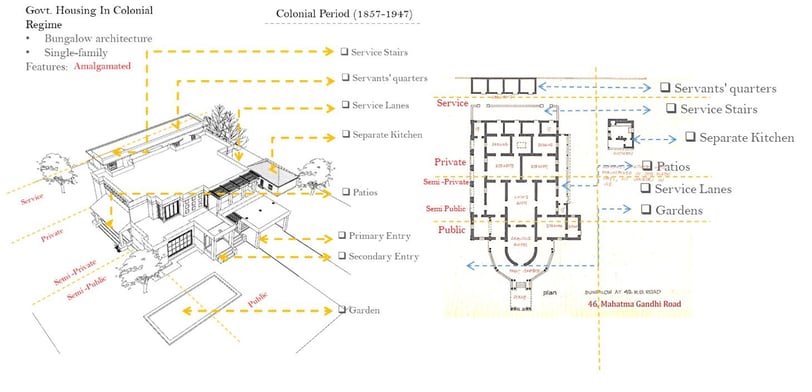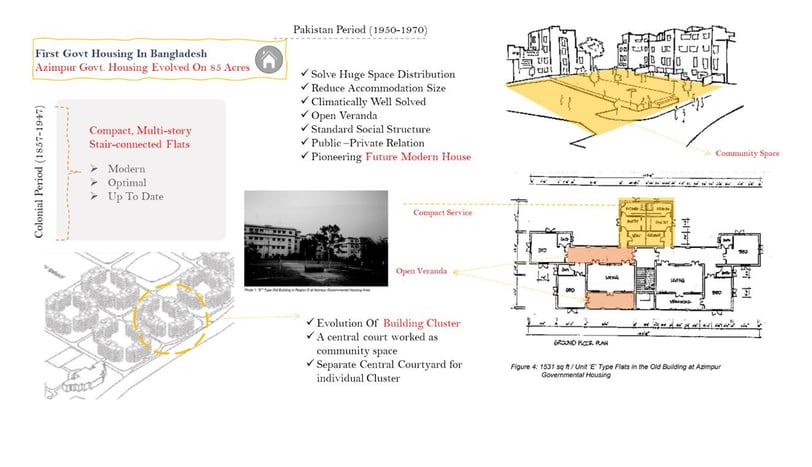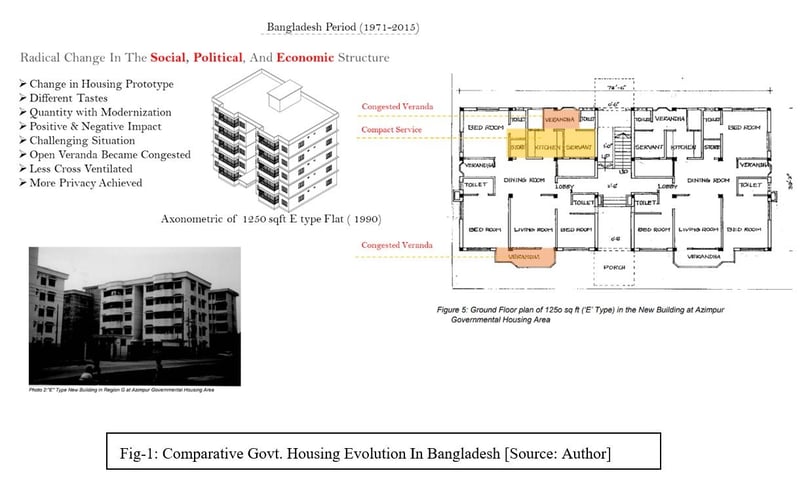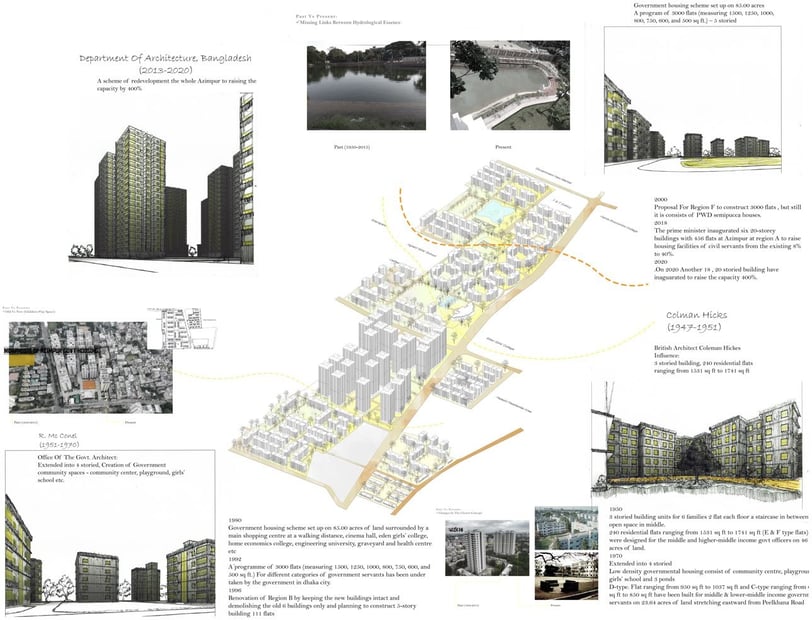History of the Transformation of Public Housing In Bangladesh: Azimpur Govt Housing: The First Public Housing
In this blog, I have discussed and analysed how the historical evolution and transformation of public housing in Bangladesh happened and detailed the application of vernacular and contextual elements in low-rise public housing can be executed.
SUSTAINABLE LIVINGFEATURED
Muhammad Golam Sami
10/11/20225 min read


Image: Morphological transformation of Azimpur Govt. Housing, Dhaka-1205
Background of Public Housing In Bangladesh:
After the departure of the colonial regime, a massive change in public sector housing took place in Bangladesh during the East Pakistan era. Colonial public houses adapted bungalow architecture, which could support a single-family. These bungalows amalgamated gardens, patios, servants' quarters, and even service stairs and service lanes. Post-colonial architecture began in the 1950s and witnessed a tremendous change in the government housing sector. British architecture's compact, multi-story stair-connected flats were more modern, optimal, and up-to-date. In British architecture, however, the expensive problems that arose in massive space distribution despite the houses becoming climatically well-solved transformed during the Pakistan period by reducing the accommodation size and leaving the verandah open. The change in the size of the room and the modified distribution of public-private space provided a standard for the social structure of the time and pioneered future climate-friendly housing. Later in the Bangladesh period, there was a radical change in the social, political, and economic structure and a change in the housing prototype due to differences in tastes, which in many cases provided a positive and a negative impact, creating a challenging situation.








The slow but significant changes in housing type have led to distinct phases in the sector's development. In Dhaka, the following broad categorization is possible (Habib, 1991).
The primary housing phase I stated above was held in Pakistan Period; Azimpur and Motijheel Government Housing Estates, created in the 1950s by architects E.C. Hicks and RMcConnel, are the most notable examples of this phase. In this region, their designs heralded the dawn of an entirely new era in dwelling design. Two unique patterns in overall planning and building layouts can be identified.
The first is a standard linear spacing between buildings that leaves linear open spaces between them, and the second is a deliberate attempt to create an enclosed outdoor area with structures that make a secure and pleasant outdoor space under the visual control of each residence in the block.
In the secondary phase, the level of the house typology might be referred to as experimental and inventive. The development of staff housing on many university campuses in the 1960s helped to pave the way for this phase's expansion. Due to the delicate use of form and material in the S. A. Zahiruddin-designed structures at Dhakeswari Housing, BUET, Dhaka, the exterior was sophisticated.
In the third phase, a significant focus on the space economy through logical planning and design was placed in public sector housing. Baily Road's Government Officers Housing Estates represent the start of the third phase of public accommodation. Involving both the outside and inner environments was an innovative attempt at building.
Azimpur Govt. Housing:
The first government project for multi-story walk-up residential apartments for government employees within the Dhaka city limits is Azimpur Governmental Housing. The then-provincial government created this flat residential design in the 1950s, consisting of three-story building units appropriate for six families, based on a typology consisting of two flats per level and a staircase in between that had been grouped in a cluster with an open space in the center. On 46 59 acres of land, 240 residential flats (E & F type flats) were planned for middle-class and upper-middle-class government personnel. These flats ranged in size from 1531 square feet to 1741 square feet.
Considering the ever-increasing demand for government housing, these buildings were extended into four stories during the I970s. This low-density governmental housing consists of a community center, playgrounds, girls' school, and 3 ponds built on (46.00+ 1.00+2.82) =49.82 acres of land bounded by Government New Market, Pilkhana Road, and Azimpur Road. At the same time, D-type. Flats ranging from 950 sq ft to 1037 sq ft and C-type ranging from 650 sq ft to 850 sq ft have been built for middle & lower-middle income government servants on 23.64 acres of land stretching eastward from Pilkhana Road up to Sir Salimullah Muslim Orphanage. Simultaneously, 800 sq ft. C-type flats were built on 4.08 acres of land beside Palashee Maternity Centre to the east of Azimpur Road, and a government housing known as Palashee Barracks was built on 5.39 acres of land.
This public housing project is on 85 acres of land and is flanked by a major shopping mall, a movie theater, Eden Girls' College, a home economics college, an engineering university, a cemetery, a health center, etc.
This housing has four playgrounds, a community center for the local community, and a ladies club. One primary school (Agrani), two ponds, and one elementary school (Little Angle School).One primary school (Azimpur Higher Secondary Girls School), one secondary school, Azimpur mosques, a single daycare facility, and an orphanage (Sir Salimullah Muslim Orphanage).
The government constructed a three-story facility for officials and workers in the 1950s that could accommodate six family members. These structures were converted to four-story housing units in the 1970s. On a 46.00 acre site between New-market and Azimpur Road, E-type flats (1531-1741 sq ft) for government officials were built. The construction of C-type flats (800 sq ft) on 4.08 acres next to Palashee Matree Shadan Kendra and Palashee Barrack on 5.39 acres was done simultaneously with the construction of D-type flats (950-1037 sq ft) and C-type flats (650-810 sq ft) for government employees on a total of 23.64 acres east of Sir Salimullah Muslim Orphanage. In the 1990s, five-story buildings with 1000-square-foot apartments for 10 families were once again constructed to meet the increased need for housing, built on a 46.00-acre plot of undeveloped property.
The pond next to the playfield south of this location was filled again to construct three 12-story, 1250-square-foot apartments and two 1500-square-foot apartments for law enforcement officers. To enhance the quality of the housing stock and build new homes, the current administration decided to destroy outdated housing complexes in the late 1990s. Planning and revising the current master plan for the Azimpur Governmental Housing Area is the responsibility of the Department of Architecture. According to location and usage, the entire housing area has been designated in the master plan as regions A, B, C, D, E, F, and G. These areas total 85 acres and are respectively 23.64, 4.08, 2.82, 46.00, 2.07, 5.39, and 1.00 acres.
I have added a transformation historic infographic below with the help of my developed BIM of Azimpur Govt. Housing. [ Click to see full preview]
Meet The Author
Related ARTICLES
Related PROJECTS
Revising The Renovation of Azimpur Govt. Housing , Dhaka - 1205
This project aims to provide a friendly framework for the future renovation or regeneration of these housing units in Bangladesh, taking into account the climatic and social factors that compel them to analyze the past, present, and future effects of this radical change in government housing, along with providing a structured policy for establishing government prototypes that enable government housing projects to be more sustainable and eliminate adverse effects.
Image: Azimpur Govt. Housing Renovation Visual at Bird's Eye
Location: Dhaka-1205; Year: 2023






